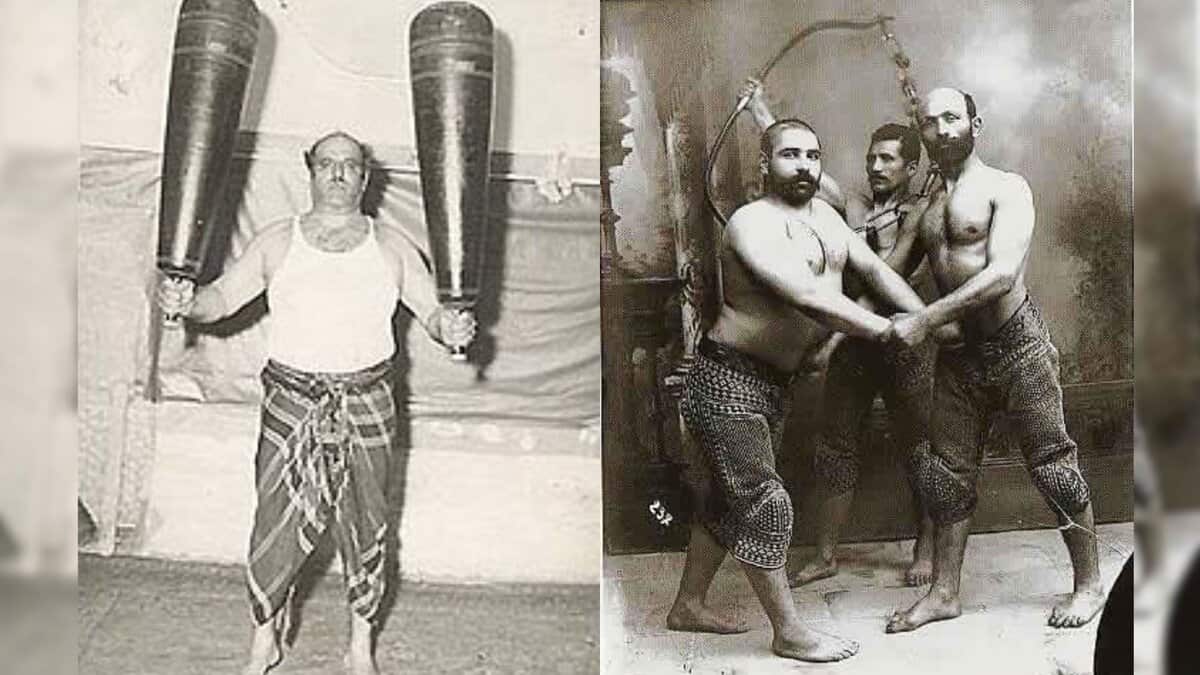
Wrestling is one of the oldest sports in the world and is a traditional sport in many countries throughout the world. It has been practiced in all ancient civilisations including Egypt and China. In Indian mythology we have heard of wrestling bouts between Bheema and his rivals. In different countries, different forms of wrestling have evolved.
In Turkey, oil wrestling (where the participants are drenched in oil) is a national sport and is called Karakucak. It dates back to the Babylonian times. In Japan, there is Sumo wrestling which also has ancient roots. In China, a wrestling style called Shuai jiao reportedly has a history of over 4,000 years.
But out of all these forms, it is the Iranian Vrazesh-e-Pahlevani that has got the honour of being recognised as an Intangible World Cultural Heriatge by UNESCO. The Iranian form of wrestling, known as the “Pahlevani and Zoorkhaneh rituals,” was honored by UNESCO in 2010 because it is considered the world’s longest-running system of athletics that combines wrestling with a rich spiritual and cultural tradition.
UNESCO honoured Pahlevani
According to the UNESCO website, the ancient martial art combines elements of Islam, Gnosticism and ancient Persian beliefs. It is a rich collection of gymnastic and callisthenic movements performed by ten to twenty men, each wielding instruments symbolizing ancient weapons and also development of one’s inner personality.
The ritual takes place in a Zoorkhane – a sacred domed structure with an octagonal sunken arena and audience seats. The Morshed (master) who leads the Pahlevani ritual performs a ritual wherein he recites epic and Gnostic poems and beats out time on a Zarb goblet drum.
The poems he recites transmit ethical and social teachings and constitute part of Zoorkhanei literature. Participants in the Pahlevani ritual may be drawn from any social strata or religious background, and each group has strong ties to its local community. They often work to assist the needy and do other social service.
Trained in ethical values
During apprerenticeship, students are trained in ethical and chivalrous values under the supervision ofa Pishkesvat (champion). Those who master the individual skills and arts, observe religious principles,and pass the moral tests, may acquire the rank of Pahlevan – a hero. It denotes authority within the community. At present, there are 500 Zoorkhanes across Iran, each comprising practitioners, founders and a number of Pishkesvats.
The Pahlevani system has recieved worldwide praise for its holistic approach to physical and moral development, blending ancient Persian beliefs and spirituality. In other words, it is not just a sport but also a practice that enbodies spiritual and culturally binding aspects of life.
Dates back to Persian empire
The sport dates back to the Persian Empire, particularly the Parthian and Sassanian eras. The term “Pahlavan” means “hero” or “champion” and the sport was originally designed for training warriors, cultivating physical strength, combat skills, and ethical virtues.
Its roots are deeply embedded in Iran’s pre-Islamic as well as Islamic culture, blending elements of Zoroastrianism, Persian mythology, Shia Islam and Sufism.
Unique aspects of Pahlevani
The training in Pahlevani involves ritualistic gymnastic exercises using traditional equipment like wooden clubs, shields, and chains, conducted in rhythm to music and poetic chants.
The highlight of the practice is the koshti pahlevani, a style of folk wrestling with an extensive repertoire of techniques such as throws, locks, and takedowns, reflecting its origins as a pragmatic combat system.
The sport gained prominence during the Safavid dynasty and reached cultural zeniths under Qajar rule, especially during the reign of Nāser al-Din Shah, where Nowruz competitions were popular. Despite challenges it faced during the Pahlavi era and early years after the 1979 revolution, Pahlevani was revived and is now recognized by UNESCO as a practice that symbolizes Iranian national pride and cultural resilience.
Emphasis on humility and justice
Beyond its physical aspects, Pahlevani represents a moral code emphasizing humility, justice, courage, and generosity. It continues to be practiced not only in Iran but also in neighboring countries, maintaining an enduring legacy of the ancient Persian civilization’s heroic and spiritual ideals.
In the history and traditions of Iran, the most prominent Pahlevans include the legendary Rostam, mentioned in the famous Shahnameh epic. He was well known for his courage, chivalry and integrity.
In modern times, the most reputed practitioners are Gholamreza Takhti, who is considered the most famous modern day Pahlevan. He was a celebrated wrestler known for his honor and social activism. He is often called “Jahan Pahlevan” (world champion).
Nowadays, from Iran, the sport is spreading to surrounding countries like Afghanistan, Iraq and Azerbaijan. Ancient Persians believed that the development of physical and mental strength could be used to enhance spirituality.
Thus, apart from preparing warriors for battle, the training is aimed at promoting kindness and humility in the individual and society. The practitioners have a very apt saying by which they lead their lives. The saying is: “If you wish to acquire wisdom, first learn to be humble. A mountain cannot be irrigated by a river.” It is a perfect way to learn a sport and lead life along the honourable ideals of service and sacrifice.



